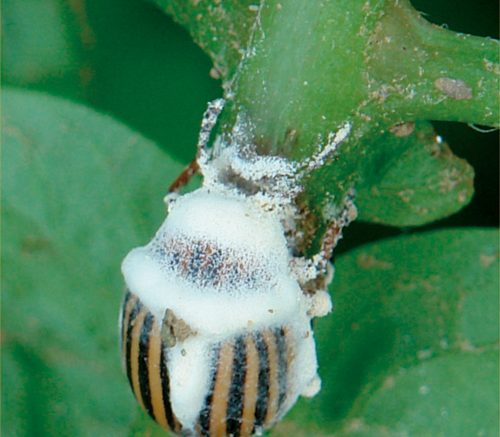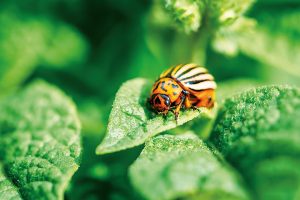By Mark Milenski and Manuel Campos, Entomologist, BioSafe Systems
The year 1859 may not hold much significance to most people in the potato industry; however, it was during that year that a new, highly destructive pest first targeted potato crops in the Nebraska Territory. This pest has had many names including the potato bug, Colorado beetle and ten-striped spearman, but most know it by its common name, the Colorado potato beetle (Leptinotarsa decemlineata).
The Colorado potato beetle (CPB) was first identified in 1824 from specimens collected on buffalo-bur (Solanum rostratum) in the Rocky Mountains, leading to its distinctive name. CPB quickly developed a reputation as one of the most invasive pests attacking solanaceae crops, which include eggplants, tomatoes and peppers; however, over time it developed a strong attraction to potato crops.
This tiny, yet distinctive, pest – with adults having a bright yellow-orange body and five bold, brown stripes along the length of each of its elytra – is considered among the most devastating insect defoliators of potatoes. Its larvae, identified by their large nine-segment abdomen and orange-pink color, may also defoliate potato plants, resulting in yield losses up to 100 percent if the damage occurs prior to tuber formation.
Female CPBs are highly prolific and capable of laying between 300 and 500 eggs in a four- to five-week period, with eggs typically deposited in batches of 30 under host leaves. Larvae move through four distinct instar growth stages, with the fourth stage lasting four to seven days. Once they reach full size, they transition to non-feeding pre-pupa and drop to the soil to burrow several inches down and pupate. Within five to 10 days, the adult beetle emerges to feed and mate, advancing from egg to adult in as few as 21 days. Depending on the region, some locations can see three or more generations per season.
Management Challenges
The most challenging trait of CPB is its uncanny ability to develop rapid resistance to conventional insecticides. CPB can develop rapid resistance due to a variety of mechanisms, including enhanced metabolism, target site insensitivity, reduced insecticide penetration and increased excretion.
Many conventional insecticides have shown rapid reduction in efficacy, with different populations in different geographic regions developing known resistance to an estimated 56 conventional insecticides. A few examples of common chemistries with known CPB resistance include carbamates, organophosphates, synthetic pyrethroids/pyrethrins and neonicotinoids. There also has been evidence of CPB developing behavioral resistance, meaning larvae and/or adults migrate away from treated areas where resistance to an insecticide has been established. The larvae or adult may migrate out of the field, but it only pushes them into another nearby host.
Resistance management practices are critical for effective control of CPB. A combination of cultural, biological and chemical strategies is required to maintain consistent management of larvae and adult populations. Monitoring and pest thresholds should be utilized as a key component in a grower’s IPM program, with many educational resources suggesting chemical application when thresholds reach 15 adults, 75 small larvae or 30 large larvae per 50 plants. Potato crops can typically tolerate 20 percent defoliation without reduction in yield, although this is highly dependent on time of season and cultivar. Some cultural controls that can be employed and have proven to effectively reduce CPB incidence and severity include crop rotation, use of mechanical barriers, early or late planting and trap crops.
Management Innovations
Although there isn’t one cure-all insecticide or 100-percent-suppression program to manage Colorado potato beetle, new and innovative tools and strategies are being developed through the collaboration of university researchers, growers and bio-innovation companies. Some of these new tools are showing promising results when incorporated in IPM programs for CPB. Some products that are gaining traction in the fight against CPB are mycoinsecticides containing the fungus Beauveria bassiana or botanical insect growth regulators made with plant extracts such as azadirachtin.
Beauveria bassiana, specifically the ANT-03 strain, which is approved for organic production, has shown replicated in-field trial results of up to 80 percent reduction in larvae and 75 percent reduction in adult beetles. This unique strain of Beauveria bassiana infects CPB through direct contact with fungal spores, through ingestion of treated host foliage and through transfer from one beetle to another. Beauveria bassiana conidia aggressively release additional spores into the field environment, helping to provide control of larval and adult beetles throughout most of the season.
In addition, studies have shown synergistic properties between Beauveria bassiana and imidacloprid, providing increased efficacy against multiple instar stages and adults. Although trials are still being conducted on additional compatibility between Beauveria bassiana and other traditional insecticides, the unique ANT-03 strain has proven to be highly aggressive on CPB and is a powerful tool that has not shown resistance potential.
Botanical insecticides/nematicides are used to control the early lifecycle of CPB by acting as an insect growth regulator. Tests using a 3-percent concentration of azadirachtin have shown that it can help break up resistant populations of early larval stages and has shown synergistic properties when used in combination with bio-controls such as Beauveria bassiana and other conventional insecticides. Some studies have found that rotational sprays of azadirachtin-based insecticides and Bt (Bacillus thuringiensis) have shown stronger efficacy against early larval stages than either product used individually; however, it was noted efficacy was strongest when azadirachtin was applied first and followed four to five days after with a Bt.
There is no true silver bullet product or approach to managing Colorado potato beetle in potatoes or any other affected crops. The only way to reduce crop losses and achieve long-term management of CPB is through a truly integrated approach to help inhibit the further development of resistance challenges. Growers must understand the enemy they’re battling and utilize a multi-attack strategy that rotates different insecticide groups and incorporates non-chemical cultural practices in an IPM program. We’ve all heard it before and it’s been repeated time and time again, but a discussion of CPB warrants reiterating the age-old adage that an ounce of prevention is worth a pound of cure.



